Cenozoic Marine Basin Evolution in the Western North Aegean trough Margin: Seismic Stratigraphic Evidence
Abstract
1. Introduction
2. Regional Setting
2.1. Regional Tectonic Setting
2.2. Regional Cenozoic Stratigraphy
3. Methodology
3.1. Dataset and Data Processing
3.2. Domains Configuration
3.3. Seismic Interpretation
4. Results
4.1. Seismic Facies
- Seismic facies Si shows the parallel internal configuration with well-stratified reflectors of moderate-to-high amplitude and high frequency. The associated packages display high continuity of sheet-shaped geometry in the central regions of the mini-basins and a wedge-shaped closer to the slopes.
- Seismic facies Sii comprises semi-continuous to continuous subparallel reflectors, with locally observed internal unconformities. The amplitude of the reflectors is observed to be low to moderate with high frequency. They follow a sheet (basinwards) to wedge (landwards) geometry.
- Seismic facies Siii shows subparallel-to-wavy internal configuration of medium continuity with distinct variations of moderate- to high-amplitude reflectors and low frequency. It is more recognizable in the deeper locations of the mini-basin following a sheet-to-wedge shape in accordance with the terminations of the associated reflectors.
- Seismic facies W shows a seismic image of wavy-to-hummocky reflectors with complex geometry. It illustrates poor continuity with an acoustic character of low-to-moderate amplitude and low frequency.
- Seismic facies M is only observed locally, in the northeastern part of the study area, (Domain C), where the associated seismic package is constrained by high-amplitude top and bottom reflectors. The internal reflector configuration displays a transparent and hummocky image with lens geometry and updoming features.
- Seismic facies C is of low amplitude, chaotic internal configuration with discontinuous reflectors, and no clear coherent geometry. The presence of the facies is associated with areas of either a disturbed acoustic image due to tectonism or areas of no coherent geometry.
4.2. Seismic Stratigraphic Framework
- Seismic Unit 1 (SU.1) is marked by the reflector of sea bottom and H1. It is attributed to an Upper Quaternary age and illustrates a constant seismic signature dominated by parallel, dense and high-amplitude reflectors of high frequency. The time thickness of the unit varies from 0.3 s in the northwestern margin (Domain A) to 0.9 s in the southeastern and central areas of the trough (Domains B and D).
- Seismic Unit 2 (SU.2) is marked by H1–H2 horizons and correlates with the Lower Quaternary age. The acoustic signature of the unit is dominated by a moderate variation of parallel to subparallel reflectors of high-to-moderate amplitude. The time thickness of the unit ranges from 0.45 s to more than 0.8 s in the southern areas (Domain B).
- Seismic Unit 3 (SU.3) is marked by H2–H3 horizons and attributed a Pliocene age. It illustrates parallel to sub-parallel reflectors of moderate-to-high amplitude and high frequency. The time thickness of the unit ranges from approximately 0.4 s (Domain A) to its maximum mapped thickness, near western Sporades (Domain B) reaching more than 1.5.
- Seismic Unit 4 (SU.4) is marked by H3–H4 horizons and correlates with the Upper Miocene age. The top of the unit is bounded by a well-defined, high-amplitude reflector (H3, with high regional importance as it is associated with the top surface of the Messinian), the strong acoustic presence of which is tracked, almost in all the available seismic profiles. The time thickness of the unit varies from 0.2 s to more than 0.7 s.
- Seismic Unit 5 (SU.5) is marked by H4–H5 reflectors and attributed to the Middle Miocene age. The seismic signature of the unit is characterized by semi-parallel-to-wavy reflectors of low frequency, the time thickness of which varies from 0.25 to 0.9 s.
- Seismic Units 6 (SU.6), marked by H5–H6 horizons, is attributed to the Lower Miocene age. It is characterized by low-frequency and moderate-amplitude reflectors of semi-parallel geometry, displaying a thickness of 0.2–0.5 s.
- Seismic Unit 7 (SU.7) is marked by H6–H7 horizons and correlates with the Oligocene age. It consists of semi-parallel-to-parallel, low- to moderate-amplitude reflectors of moderate frequency and continuity. Its thickness ranges from 0.25 to 0.7 s.
- Seismic Unit 8 (SU.8) is marked by H7–H8 horizons, and it is tentatively attributed to an undifferentiated Eocene age. Its reflector configuration is characterized by semi-parallel, low- to moderate-amplitude reflectors of moderate frequency and continuity. Even though it is poorly constrained, it illustrates a time thickness ranging from 0.4 s to more than 1.2 s.
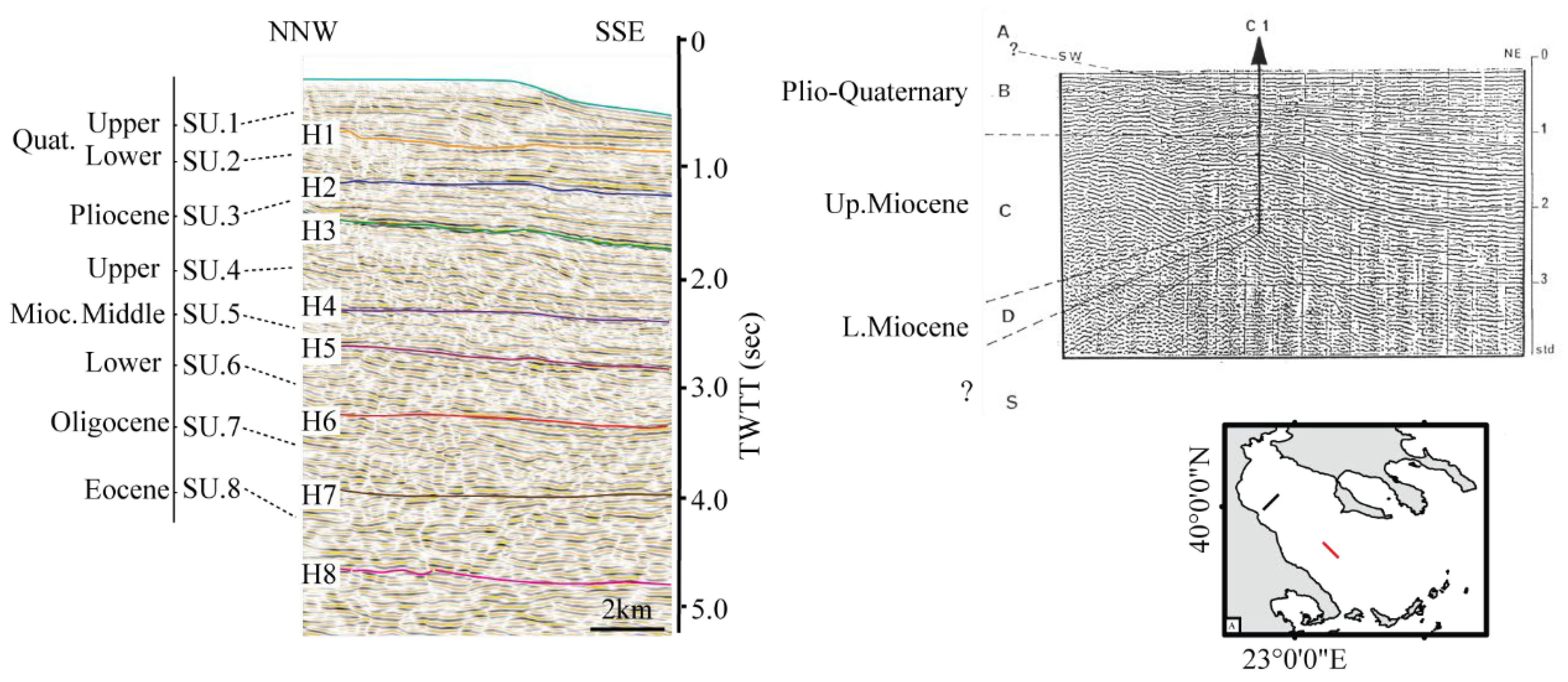
4.3. Seismic Architecture of the Western-Central NAT
4.3.1. Domain A, Thermaikos Shelf
4.3.2. Domain B, Western Sporades
4.3.3. Domain C, Sithonia–Athos Peninsulas
4.3.4. Domain D, Eastern Sporades
5. Discussion
5.1. Paleogene
5.2. Lower-Middle Miocene
5.3. Upper Miocene
Implications of the NAF’s Deformation Timing
5.4. Pliocene-Quaternary
6. Conclusions
- A trough-shaped roughly N–S-trending basin extending from northern mainland Greece to the outer Thermaikos slope formed as a result of persistent NE–SW extension since early Paleogene.
- This Axios basin formed to the north of the Upper Cretaceous Vardar Ocean suture zone that was confined in the outer periphery of the NAT that was elevated.
- The southern extents of the Axios basin remained continuously marine since the Eocene, with possible intermittent marine connections to Paratethys at Cenozoic Sea level highstands and possibly connecting to the Mesohellenic Basin.
- The sedimentary stratigraphic record, as reflected by seismic facies observed in the western NAT, is in good agreement with the directions of extension proposed in previous studies: (a) the NE–SW extension observed in late Paleogene–early Miocene sections on land, (b) a gradual shift toward a WNW–ESE extensional regime during the Miocene, and (c) a consequent gradual prevalence of an NNE–SSW extension in the Pliocene-Quaternary.
- The kinematic timing of the North Anatolian Fault propagation in the NAT is outlined. The mapping of compressional deformation in the Upper Miocene–Early Pliocene in the western Sporades constrains the arrival of the NAF, transitioning to the north during the Quaternary.
- The likely presence of Messinian evaporites, including salt, is postulated in the western regions of the NAT, south of the Chalkidiki Peninsula as established on the basis of BES and TES.
Author Contributions
Funding
Institutional Review Board Statement
Informed Consent Statement
Data Availability Statement
Acknowledgments
Conflicts of Interest
References
- Jackson, J. Active Tectonics of the Aegean Region. Annu. Rev. Earth Planet. Sci. 1994, 22, 239–271. [Google Scholar] [CrossRef]
- Le Pichon, X.; Şengör, A.M.C.; Kende, J.; İmren, C.; Henry, P.; Grall, C.; Karabulut, H. Propagation of a Strike-Slip Plate Boundary within an Extensional Environment: The Westward Propagation of the North Anatolian Fault. Can. J. Earth Sci. 2016, 53, 1416–1439. [Google Scholar] [CrossRef]
- Reilinger, R.E.; McClusky, S.C.; Oral, M.B.; King, R.W.; Toksoz, M.N.; Barka, A.A.; Kinik, I.; Lenk, O.; Sanli, I. Global Positioning System Measurements of Present-Day Crustal Movements in the Arabia-Africa-Eurasia Plate Collision Zone. J. Geophys. Res. Solid Earth 1997, 102, 9983–9999. [Google Scholar] [CrossRef]
- Armijo, R.; Meyer, B.; Hubert, A.; Barka, A. Westward Propagation of the North Anatolian Fault into the Northern Aegean: Timing and Kinematics. Geology 1999, 27, 267. [Google Scholar] [CrossRef]
- Savostin, L.A.; Sibuet, J.-C.; Zonenshain, L.P.; Le Pichon, X.; Roulet, M.-J. Kinematic Evolution of the Tethys Belt from the Atlantic Ocean to the Pamirs since the Triassic. Tectonophysics 1986, 123, 1–35. [Google Scholar] [CrossRef]
- Royden, L.H. Evolution of Retreating Subduction Boundaries Formed during Continental Collision. Tectonics 1993, 12, 629–638. [Google Scholar] [CrossRef]
- Jacobshagen, V. Orogenic evolution of the Hellenides: New aspects. In Active Continental Margins—Present and Past; Springer: Berlin, Heidelberg, 1994; pp. 249–256. [Google Scholar]
- Dinter, D.A. Late Cenozoic Extension of the Alpine Collisional Orogen, Northeastern Greece: Origin of the North Aegean Basin. Geol. Soc. Am. Bull. 1998, 110, 1208–1230. [Google Scholar] [CrossRef]
- Walcott, C.; White, S. Constraints on the Kinematics of Post-Orogenic Extension Imposed by Stretching Lineations in the Aegean Region. Tectonophysics 1998, 298, 155–175. [Google Scholar] [CrossRef]
- Ring, U.; Gessner, K.; Güngör, T.; Passchier, C.W. The Menderes Massif of Western Turkey and the Cycladic Massif in the Aegean—Do They Really Correlate? J. Geol. Soc. 1999, 156, 3–6. [Google Scholar] [CrossRef]
- Papanikolaou, D.; Alexandri, M.; Nomikou, P.; Ballas, D. Morphotectonic Structure of the Western Part of the North Aegean Basin Based on Swath Bathymetry. Mar. Geol. 2002, 190, 465–492. [Google Scholar] [CrossRef]
- Taymaz, T.; Yilmaz, Y.; Dilek, Y. The Geodynamics of the Aegean and Anatolia: Introduction. Geol. Soc. Lond. Spec. Publ. 2007, 291, 1–16. [Google Scholar] [CrossRef]
- McKenzie, D. Active Tectonics of the Alpine--Himalayan Belt: The Aegean Sea and Surrounding Regions. Geophys. J. Int. 1978, 55, 217–254. [Google Scholar] [CrossRef]
- Faccenna, C.; Bellier, O.; Martinod, J.; Piromallo, C.; Regard, V. Slab Detachment beneath Eastern Anatolia: A Possible Cause for the Formation of the North Anatolian Fault. Earth Planet. Sci. Lett. 2006, 242, 85–97. [Google Scholar] [CrossRef]
- Brun, J.-P.; Sokoutis, D. 45 m.y. of Aegean Crust and Mantle Flow Driven by Trench Retreat. Geology 2010, 38, 815–818. [Google Scholar] [CrossRef]
- Brun, J.-P.; Faccenna, C.; Gueydan, F.; Sokoutis, D.; Philippon, M.; Kydonakis, K.; Gorini, C. The Two-Stage Aegean Extension, from Localized to Distributed, a Result of Slab Rollback Acceleration. Can. J. Earth Sci. 2016, 53, 1142–1157. [Google Scholar] [CrossRef]
- Mascle, J.; Martin, L. Shallow Structure and Recent Evolution of the Aegean Sea: A Synthesis Based on Continuous Reflection Profiles. Mar. Geol. 1990, 94, 271–299. [Google Scholar] [CrossRef]
- Sakellariou, D.; Rousakis, G.; Morfis, I.; Panagiotopoulos, I.; Ioakim, C.; Trikalinou, G.; Tsampouraki-Kraounaki, K.; Kranis, H.; Karageorgis, A.P. Deformation and Kinematics at the Termination of the North Anatolian Fault: The North Aegean Trough. In Proceedings of the 9th International INQUA Meeting on Paleoseismology, Active Tectonics and Archeoseismology (PATA), Possidi, Greece, 25–27 June 2018. [Google Scholar]
- Sakellariou, D.; Tsampouraki-Kraounaki, K. Offshore Faulting in the Aegean Sea: A Synthesis Based on Bathymetic and Seismic Profiling Data. Bull. Geol. Soc. Greece 2017, 50, 134. [Google Scholar] [CrossRef]
- Brooks, M.; Ferentinos, G. Structure and Evolution of the Sporadhes Basin of the North Aegean Trough, Northern Aegean Sea. Tectonophysics 1980, 68, 15–30. [Google Scholar] [CrossRef]
- Ferentinos, G.; Brooks, M.; Collins, M. Gravity-Induced Deformation On the North Flank and Floor of the Sporadhes Basin of the North Aegean Sea Trough. Mar. Geol. 1981, 44, 289–302. [Google Scholar] [CrossRef]
- Bulut, F.; Özener, H.; Doğru, A.; Aktuğ, B.; Yaltırak, C. Structural Setting along the Western North Anatolian Fault and Its Influence on the 2014 North Aegean Earthquake (Mw 6.9). Tectonophysics 2018, 745, 382–394. [Google Scholar] [CrossRef]
- Kiratzi, A.; Louvari, E. Focal Mechanisms of Shallow Earthquakes in the Aegean Sea and the Surrounding Lands Determined by Waveform Modelling: A New Database. J. Geodyn. 2003, 36, 251–274. [Google Scholar] [CrossRef]
- Ganas, A.; Drakatos, G.; Pavlides, S.B.; Stavrakakis, G.N.; Ziazia, M.; Sokos, E.; Karastathis, V.K. The 2001 Mw = 6.4 Skyros Earthquake, Conjugate Strike-Slip Faulting and Spatial Variation in Stress within the Central Aegean Sea. J. Geodyn. 2005, 39, 61–77. [Google Scholar] [CrossRef]
- Papanikolaou, D.; Alexandri, M.; Nomikou, P. Active Faulting in the North Aegean Basin. Spec. Pap. Geol. Soc. Am. 2006, 409, 189–209. [Google Scholar] [CrossRef]
- Laigle, M.; Hirn, A.; Sachpazi, M.; Roussos, N. North Aegean Crustal Deformation: An Active Fault Imaged to 10 Km Depth by Reflection Seismic Data. Geology 2000, 28, 71–74. [Google Scholar] [CrossRef]
- Koukouvelas, I.K.; Aydin, A. Fault Structure and Related Basins of the North Aegean Sea and Its Surroundings. Tectonics 2002, 21, 1–17. [Google Scholar] [CrossRef]
- Müller, M.D.; Geiger, A.; Kahle, H.-G.; Veis, G.; Billiris, H.; Paradissis, D.; Felekis, S. Velocity and Deformation Fields in the North Aegean Domain, Greece, and Implications for Fault Kinematics, Derived from GPS Data 1993–2009. Tectonophysics 2013, 597–598, 34–49. [Google Scholar] [CrossRef]
- Lazos, I.; Sboras, S.; Pikridas, C.; Pavlides, S.; Chatzipetros, A. Geodetic Analysis of the Tectonic Crustal Deformation Pattern in the North Aegean Sea, Greece. Mediterr. Geosci. Rev. 2021, 3, 79–94. [Google Scholar] [CrossRef]
- Floyd, M.A.; Billiris, H.; Paradissis, D.; Veis, G.; Avallone, A.; Briole, P.; McClusky, S.; Nocquet, J.-M.; Palamartchouk, K.; Parsons, B.; et al. A New Velocity Field for Greece: Implications for the Kinematics and Dynamics of the Aegean. J. Geophys. Res. 2010, 115, B10403. [Google Scholar] [CrossRef]
- McNeill, L.C.; Mille, A.; Minshull, T.A.; Bull, J.M.; Kenyon, N.H.; Ivanov, M. Extension of the North Anatolian Fault into the North Aegean Trough: Evidence for Transtension, Strain Partitioning, and Analogues for Sea of Marmara Basin Models. Tectonics 2004, 23, 1–12. [Google Scholar] [CrossRef]
- Sakellariou, D.; Tsampouraki-Kraounaki, K. Plio-Quaternary Extension and Strike-Slip Tectonics in the Aegean. In Transform Plate Boundaries and Fracture Zones; Elsevier: Amsterdam, The Netherlands, 2019; pp. 339–374. ISBN 9780128120644. [Google Scholar]
- Lybéris, N. Tectonic Evolution of the North Aegean Trough. Geol. Soc. Lond. Spec. Publ. 1984, 17, 709–725. [Google Scholar] [CrossRef]
- Roussos, N.; Lyssimachou, T. Structure of the Central North Aegean Trough: An Active Strike-Slip Deformation Zone. Basin Res. 1991, 3, 37–46. [Google Scholar] [CrossRef]
- Ferentinos, G.; Georgiou, N.; Christodoulou, D.; Geraga, M.; Papatheodorou, G. Propagation and Termination of a Strike Slip Fault in an Extensional Domain: The Westward Growth of the North Anatolian Fault into the Aegean Sea. Tectonophysics 2018, 745, 183–195. [Google Scholar] [CrossRef]
- Roussos, N. Stratigraphy and Paleogeographic Evolution of Palaeocene Molassic Basins of N. Aegean. Bull. Geol. Soc. Greece 1994, XXX, 275–294. [Google Scholar]
- Aidona, E.; Kondopoulou, D.; Scholger, R.; Georgakopoulos, A.; Vafeidis, A. Palaeomagnetic Investigations of Sediments Cores from Axios Zone (N. Greece): Implications of Low Inclinations in the Aegean. eEarth 2008, 3, 7–18. [Google Scholar] [CrossRef][Green Version]
- IFP. Rapport Sur Le Bassin de Thessalie, Grece. Unpubl.; 1965. [Google Scholar]
- Faugères, L.; Robert, C.M. Etude Sédimentologique et Minéralogique de Deux Forages Du Golfe Thermaïque (Mer Egée). Géologie Méditerranéenne 1976, 3, 209–218. [Google Scholar] [CrossRef]
- Lalechos, N.; Savoyat, E. La Sedimentation Neogene Dans Le Fosse Nord Egeen. VI Colloquiim Geol. Aegean Reg. 1979, 2, 591–603. [Google Scholar]
- Beniest, A.; Brun, J.P.; Gorini, C.; Crombez, V.; Deschamps, R.; Hamon, Y.; Smit, J. Interaction between Trench Retreat and Anatolian Escape as Recorded by Neogene Basins in the Northern Aegean Sea. Mar. Pet. Geol. 2016, 77, 30–42. [Google Scholar] [CrossRef]
- Proedrou, P.; Sidiropoulos, T. Prinos Field—Greece Aegean Basin. Struct. Traps VI AAPG Spec. Vol. 1992, 275–291. [Google Scholar]
- Proedrou, P.; Papaconstantinou, M.C. Prinos Basin—A Model for Oil Exploration. Bull. Geol. Soc. Greece 2004, 36, 327–333. [Google Scholar] [CrossRef]
- Snel, E.; Mǎrunţeanu, M.; Meulenkamp, J.E. Calcareous Nannofossil Biostratigraphy and Magnetostratigraphy of the Upper Miocene and Lower Pliocene of the Northern Aegean (Orphanic Gulf-Strimon Basin Areas), Greece. Palaeogeogr. Palaeoclimatol. Palaeoecol. 2006, 238, 125–150. [Google Scholar] [CrossRef]
- Karakitsios, V.; Cornée, J.-J.; Tsourou, T.; Moissette, P.; Kontakiotis, G.; Agiadi, K.; Manoutsoglou, E.; Triantaphyllou, M.; Koskeridou, E.; Drinia, H.; et al. Messinian Salinity Crisis Record under Strong Freshwater Input in Marginal, Intermediate, and Deep Environments: The Case of the North Aegean. Palaeogeogr. Palaeoclimatol. Palaeoecol. 2017, 485, 316–335. [Google Scholar] [CrossRef]
- Suc, J.-P.; Do Couto, D.; Melinte-Dobrinescu, M.C.; Macaleţ, R.; Quillévéré, F.; Clauzon, G.; Csato, I.; Rubino, J.-L.; Popescu, S.-M. The Messinian Salinity Crisis in the Dacic Basin (SW Romania) and Early Zanclean Mediterranean–Eastern Paratethys High Sea-Level Connection. Palaeogeogr. Palaeoclimatol. Palaeoecol. 2011, 310, 256–272. [Google Scholar] [CrossRef]
- Vigner, A. Images Sismiques Par Réflexions Verticale et Grand-Angle de La Croûte En Contexte Extensif: Les Cyclades et Le Fossé Nord-Egéen; Institut de Physique du Globe: Paris, France, 2002. [Google Scholar]
- Herron, D.A. First Steps in Seismic Interpretation; Society of Exploration Geophysicists: Tulsa, OK, USA, 2011. [Google Scholar]
- DUG Insight. DUG Insight (Version 4.9); DUG Technology Ltd.: Perth, Australia, 2021. [Google Scholar]
- Sangree, J.; Widmier, J. Seismic Stratigraphy and Global Changes of Sea Level, Part 9: Seismic Interpretation of Clastic Depositional Facies. Am. Assoc. Pet. Geol. Bull. 1978, 62, 752–771. [Google Scholar] [CrossRef]
- Mitchum, R.M.; Vail, P.R.; Sangree, J.B. Seismic Stratigraphy and Global Changes of Sea Level, Part 6: Stratigraphic Interpretation of Seismic Reflection Patterns in Depositional Sequences. Seism. Stratigr. Appl. Hydrocarb. Explor. 1977, 117–134. [Google Scholar]
- Brun, J.-P.; Sokoutis, D. Kinematics of the Southern Rhodope Core Complex (North Greece). Int. J. Earth Sci. 2007, 96, 1079–1099. [Google Scholar] [CrossRef]
- Brun, J.P.; Sokoutis, D. Core Complex Segmentation in North Aegean, A Dynamic View. Tectonics 2018, 37, 1797–1830. [Google Scholar] [CrossRef]
- Carras, N.; Georgala, D. Upper Jurassic to Lower Cretaceous Carbonate Facies of African Affinities in a Peri-European Area: Chalkidiki Peninsula, Greece. Facies 1998, 38, 153–164. [Google Scholar] [CrossRef]
- Mercier, J.L.; Sorel, D.; Vergely, P.; Simeakis, K. Extensional Tectonic Regimes in the Aegean Basins during the Cenozoic. Basin Res. 1989, 2, 49–71. [Google Scholar] [CrossRef]
- Jackson, M.P.A.; Hudec, M.R. Seismic Interpretation of Salt Structures. In Salt Tectonics; Cambridge University Press: Cambridge, UK, 2017; pp. 364–398. [Google Scholar]
- Lofi, J.; Déverchère, J.; Gaullier, V.; Gillet, H.; Gorini, C.; Guennoc, P.; Loncke, L.; Maillard, A.; Sage, F.; Thinon, I.; et al. Seismic Atlas of the Messinian Salinity Crisis Markers in the Mediterranean and Black Seas. Mem. Société Géologique Fr. 2011, 179, 72. [Google Scholar]
- Roveri, M.; Flecker, R.; Krijgsman, W.; Lofi, J.; Lugli, S.; Manzi, V.; Sierro, F.J.; Bertini, A.; Camerlenghi, A.; De Lange, G.; et al. The Messinian Salinity Crisis: Past and Future of a Great Challenge for Marine Sciences. Mar. Geol. 2014, 352, 25–58. [Google Scholar] [CrossRef]
- Montadert, L.; Letouzey, J.; Mauffret, A. Messinian Event: Seismic Evidence. Initial Reports Deep Sea Drill. Proj. 1978, 42, 1037–1050. [Google Scholar]
- Manzi, V.; Gennari, R.; Lugli, S.; Persico, D.; Reghizzi, M.; Roveri, M.; Schreiber, B.C.; Calvo, R.; Gavrieli, I.; Gvirtzman, Z. The Onset of the Messinian Salinity Crisis in the Deep Eastern Mediterranean Basin. Terra Nov. 2018, 30, 189–198. [Google Scholar] [CrossRef]
- Anastasakis, G.; Piper, D.J.W.; Kontakiotis, G.; Antonarakou, A.; Foutrakis, P. Evolution of Neogene-Quaternary Sedimentation in the North Ionian Sea Basin during the Last Stages of Continental Collision. Submitt. Mar. Geol. 2021. MARGO-S21-00263. [Google Scholar]
- Ferentinos, G. Offshore Geological Hazards in the Hellenic Arc. Mar. Geotechnol. 1990, 9, 261–277. [Google Scholar] [CrossRef]
- Needham, H.D.; Le Pichon, X.; Melguen, M.; Pautot, G.; Renard, V.; Avedik, F.; Carre, D. North Aegean Sea Trough: 1972 Jean Charcot Cruise. Bull. Geol. Soc. Greece 1973, 10, 152–153. [Google Scholar]
- Armijo, R.; Meyer, B.; King, G.C.P.; Rigo, A.; Papanastassiou, D. Quaternary Evolution of the Corinth Rift and Its Implications for the Late Cenozoic Evolution of the Aegean. Geophys. J. Int. 1996, 126, 11–53. [Google Scholar] [CrossRef]
- Rohais, S.; Joannin, S.; Colin, J.-P.; Suc, J.-P.; Guillocheau, F.; Eschard, R. Age and Environmental Evolution of the Syn-Rift Fill of the Southern Coast of the Gulf of Corinth (Akrata-Derveni Region, Greece). Bull. Société Géologique Fr. 2007, 178, 231–243. [Google Scholar] [CrossRef]
- Lykousis, V. Sea-Level Changes and Sedimentary Evolution during the Quaternary in the Northwest Aegean Continental Margin, Greece. In Sedimentation, Tectonics and Eustasy: Sea-Level Changes at Active Margins, IAS Special Publication; Wiley: Hoboken, NJ, USA, 1991; Volume 12, pp. 121–131. ISBN 9781444303896. [Google Scholar]
- Kahle, H.-G.; Straub, C.; Reilinger, R.; McClusky, S.; King, R.; Hurst, K.; Veis, G.; Kastens, K.; Cross, P. The Strain Rate Field in the Eastern Mediterranean Region, Estimated by Repeated GPS Measurements. Tectonophysics 1998, 294, 237–252. [Google Scholar] [CrossRef]
- Le Pichon, X.; Chamot-Rooke, N.; Lallemant, S.; Noomen, R.; Veis, G. Geodetic Determination of the Kinematics of Central Greece with Respect to Europe: Implications for Eastern Mediterranean Tectonics. J. Geophys. Res. Solid Earth 1995, 100, 12675–12690. [Google Scholar] [CrossRef]
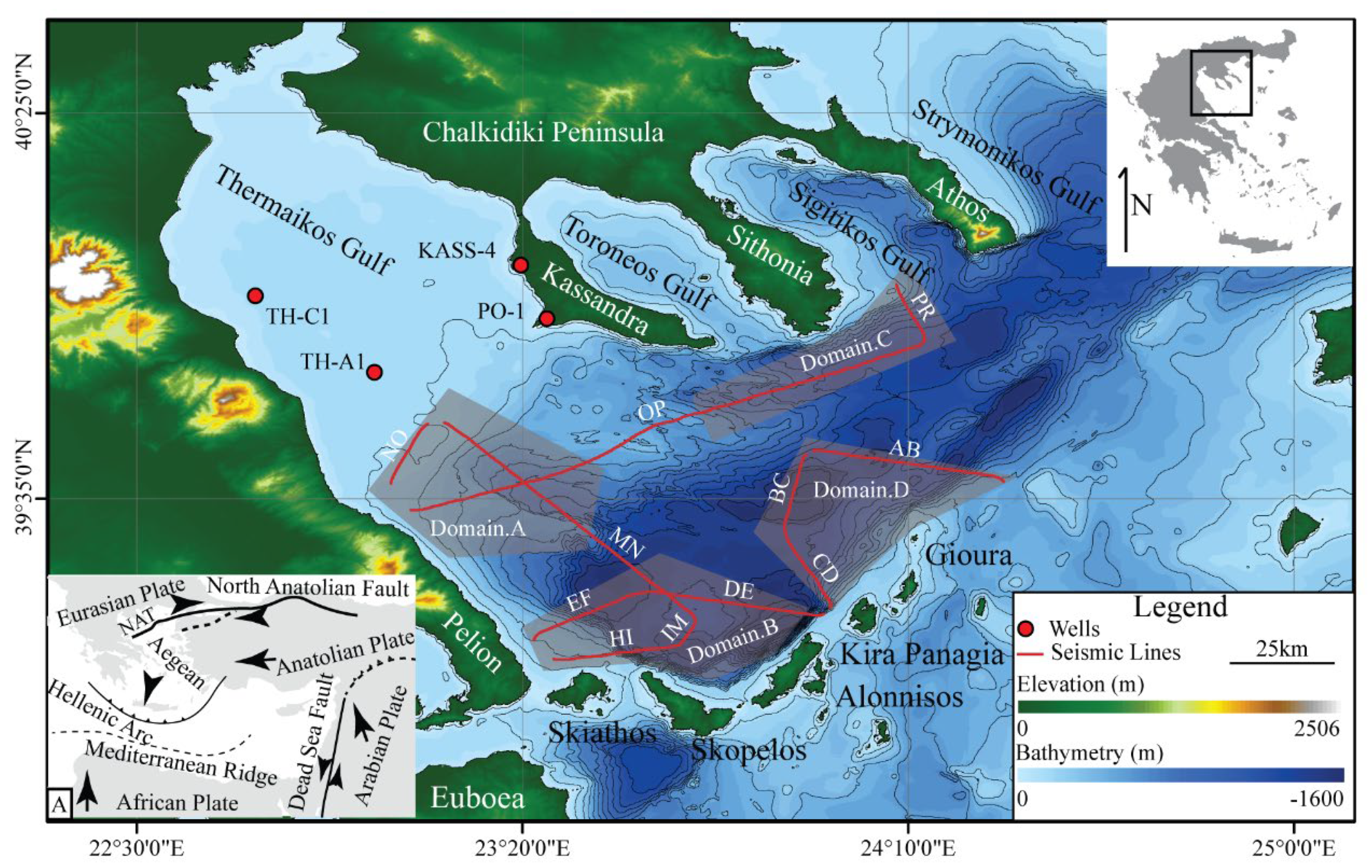
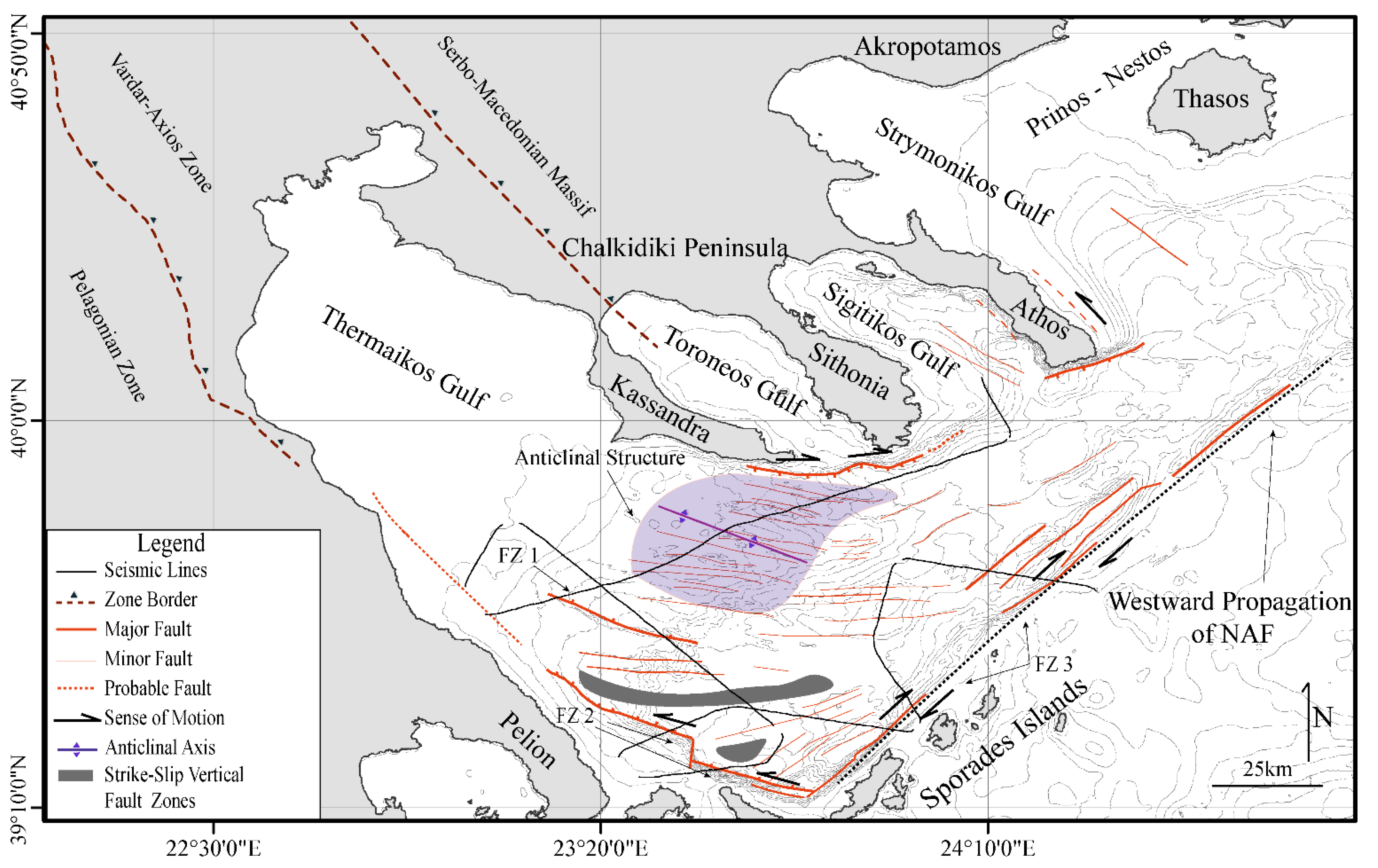
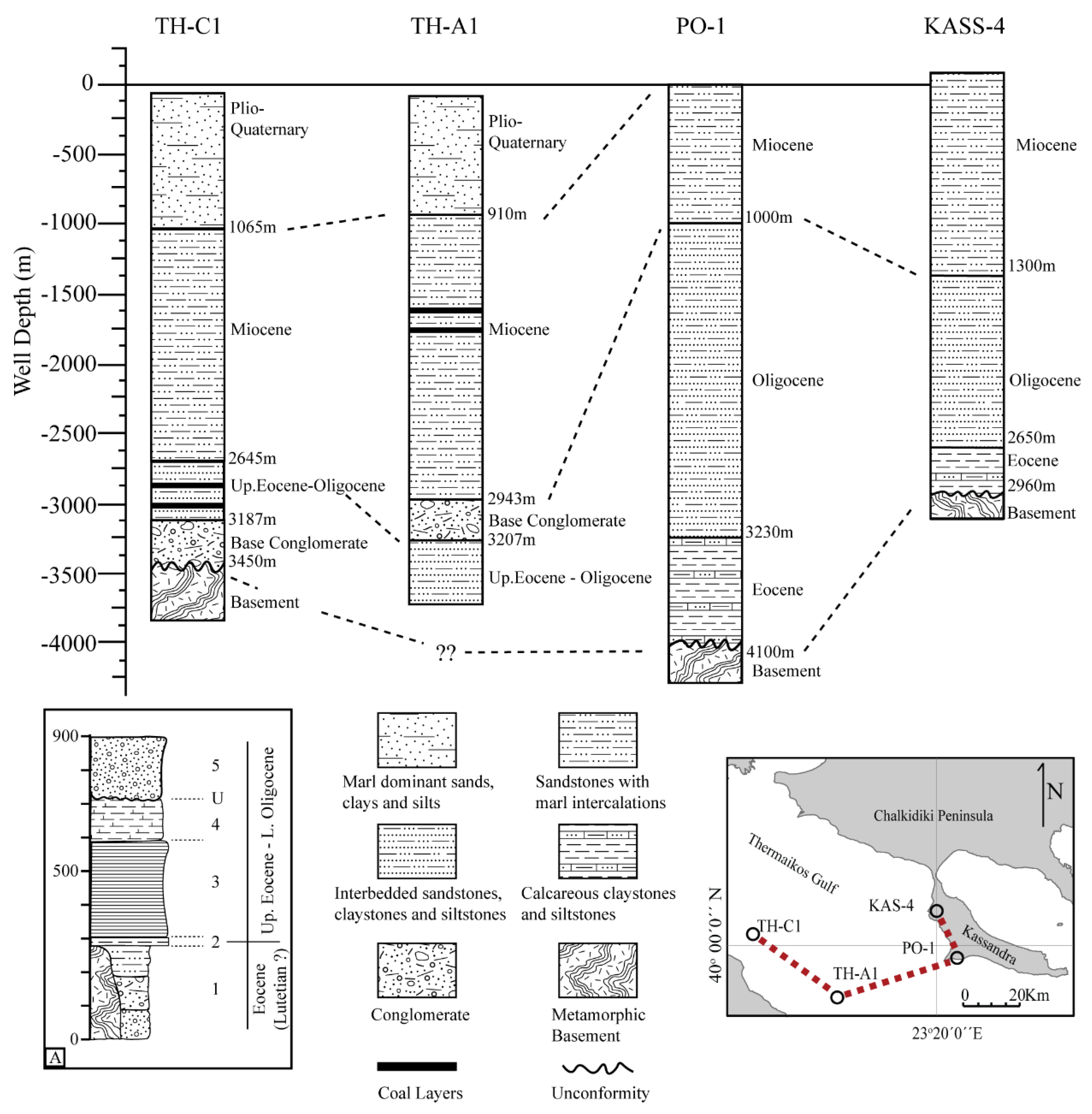
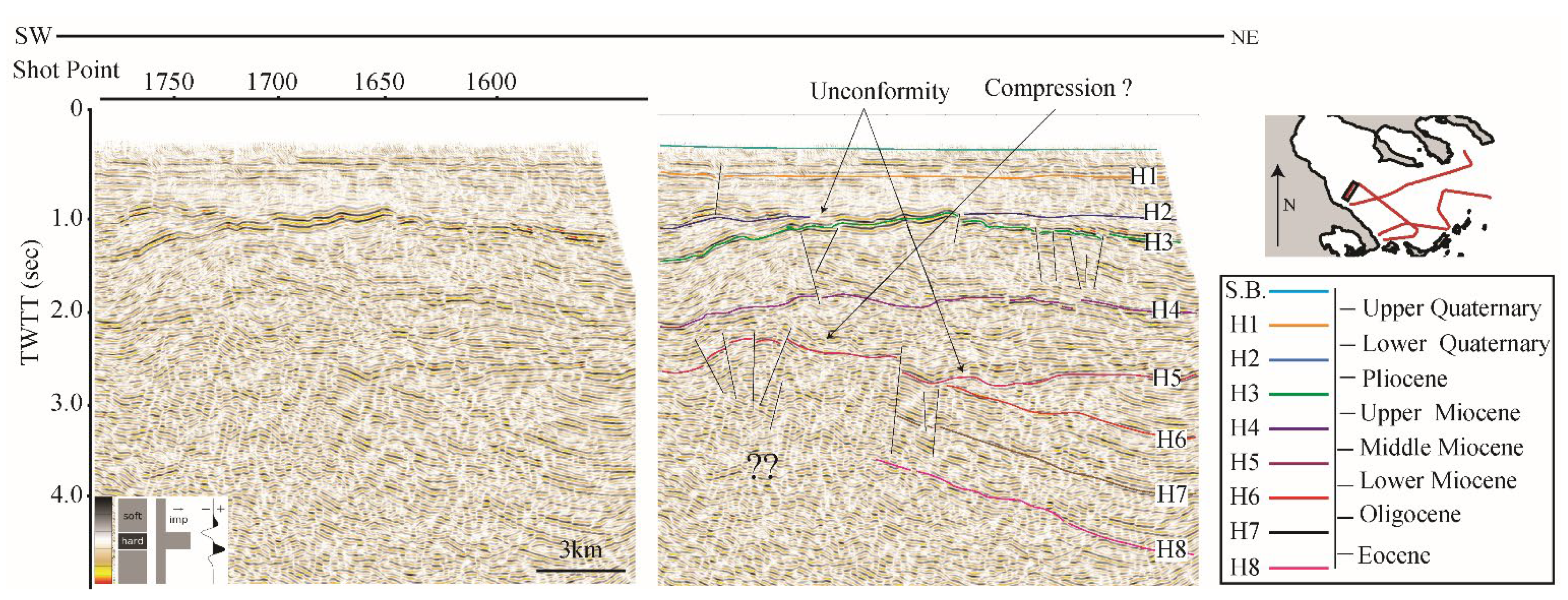
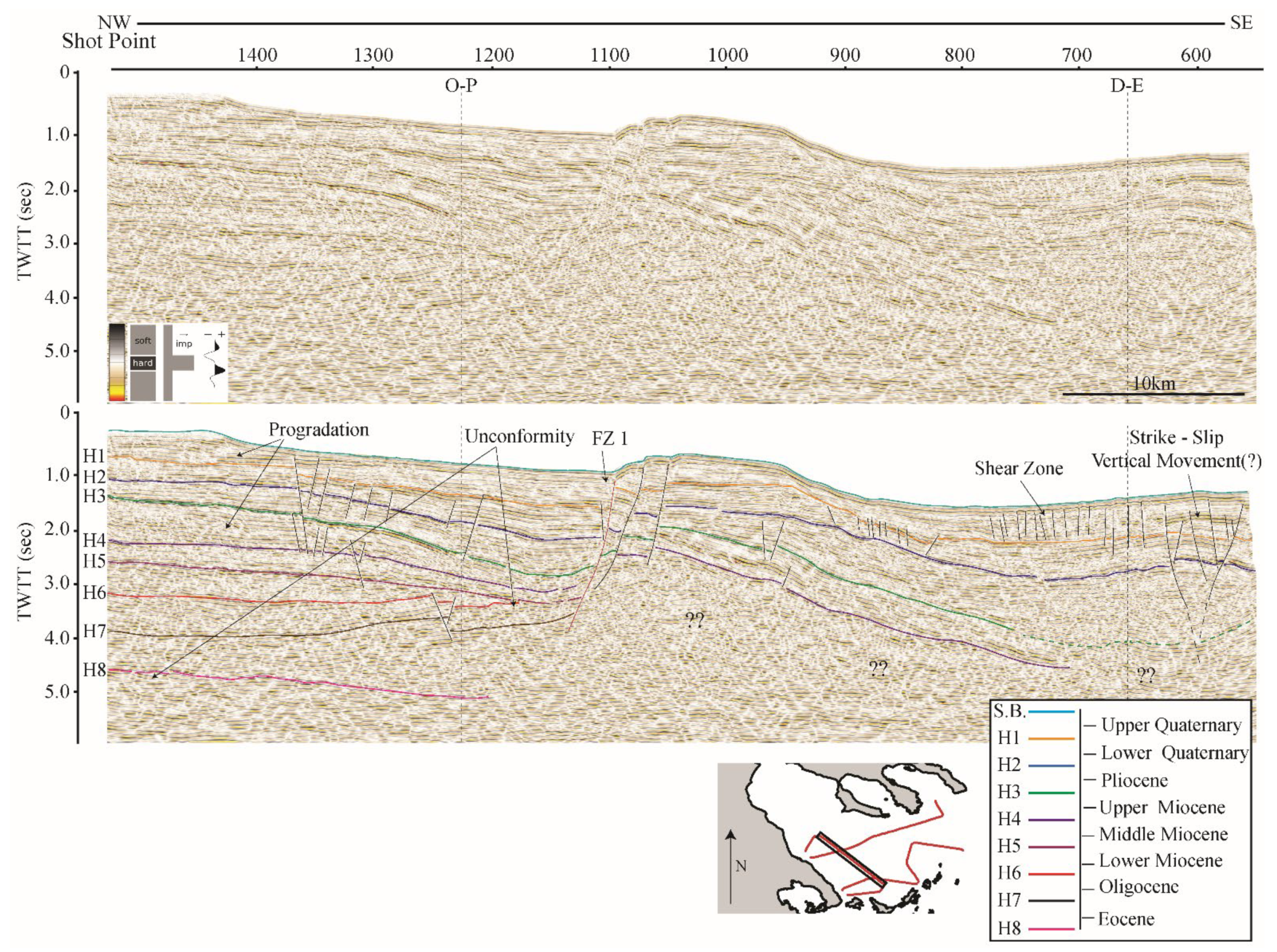

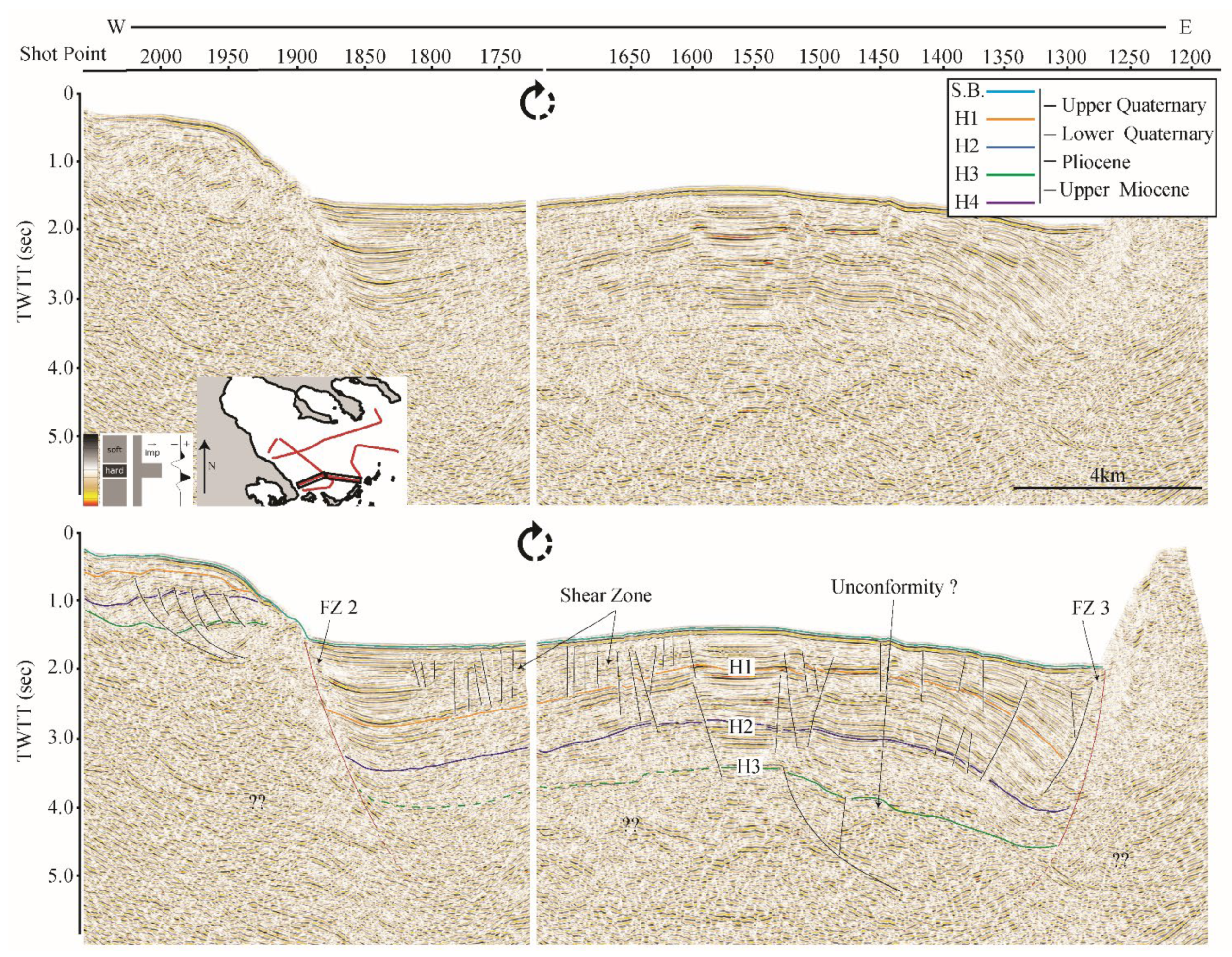
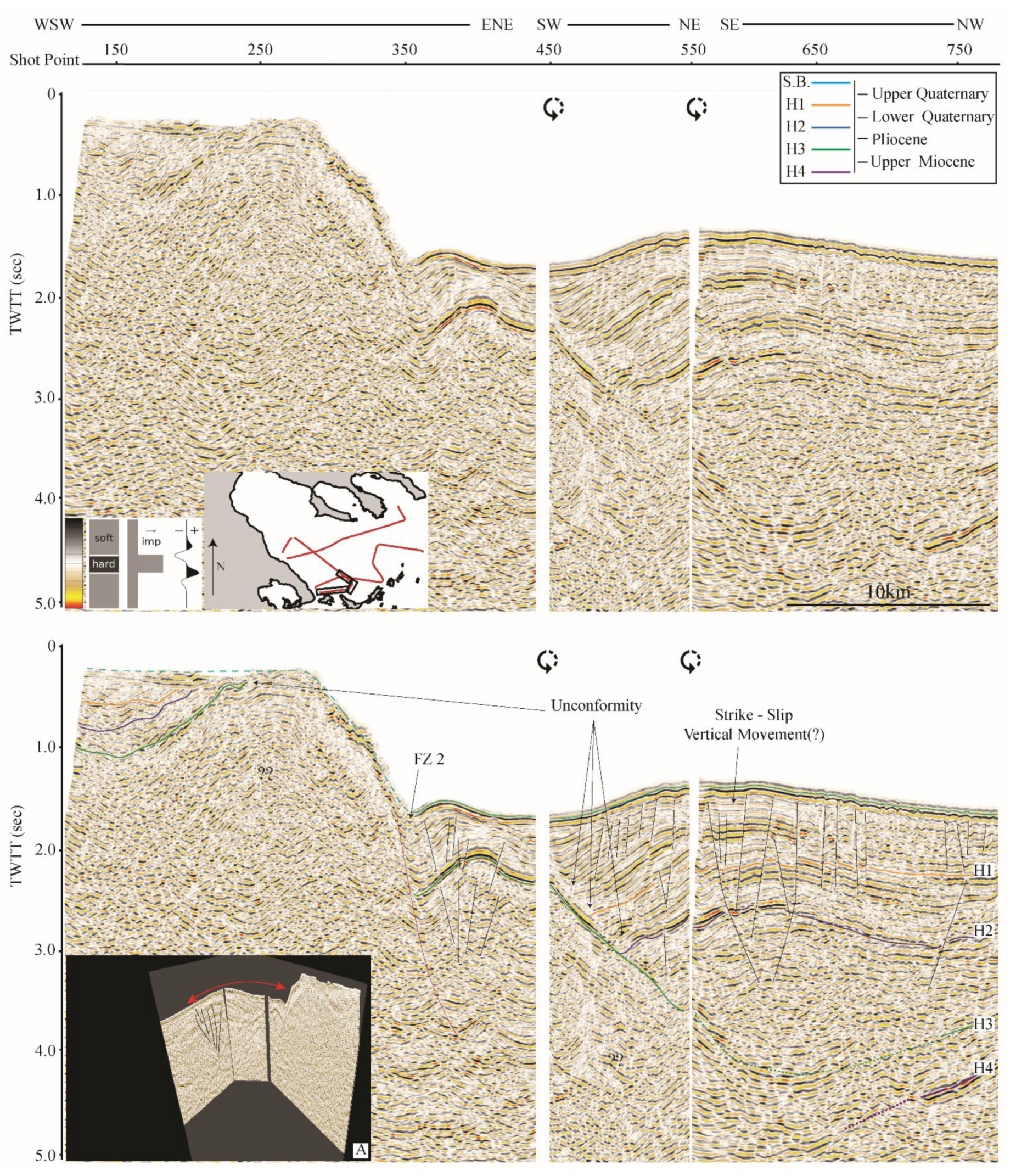
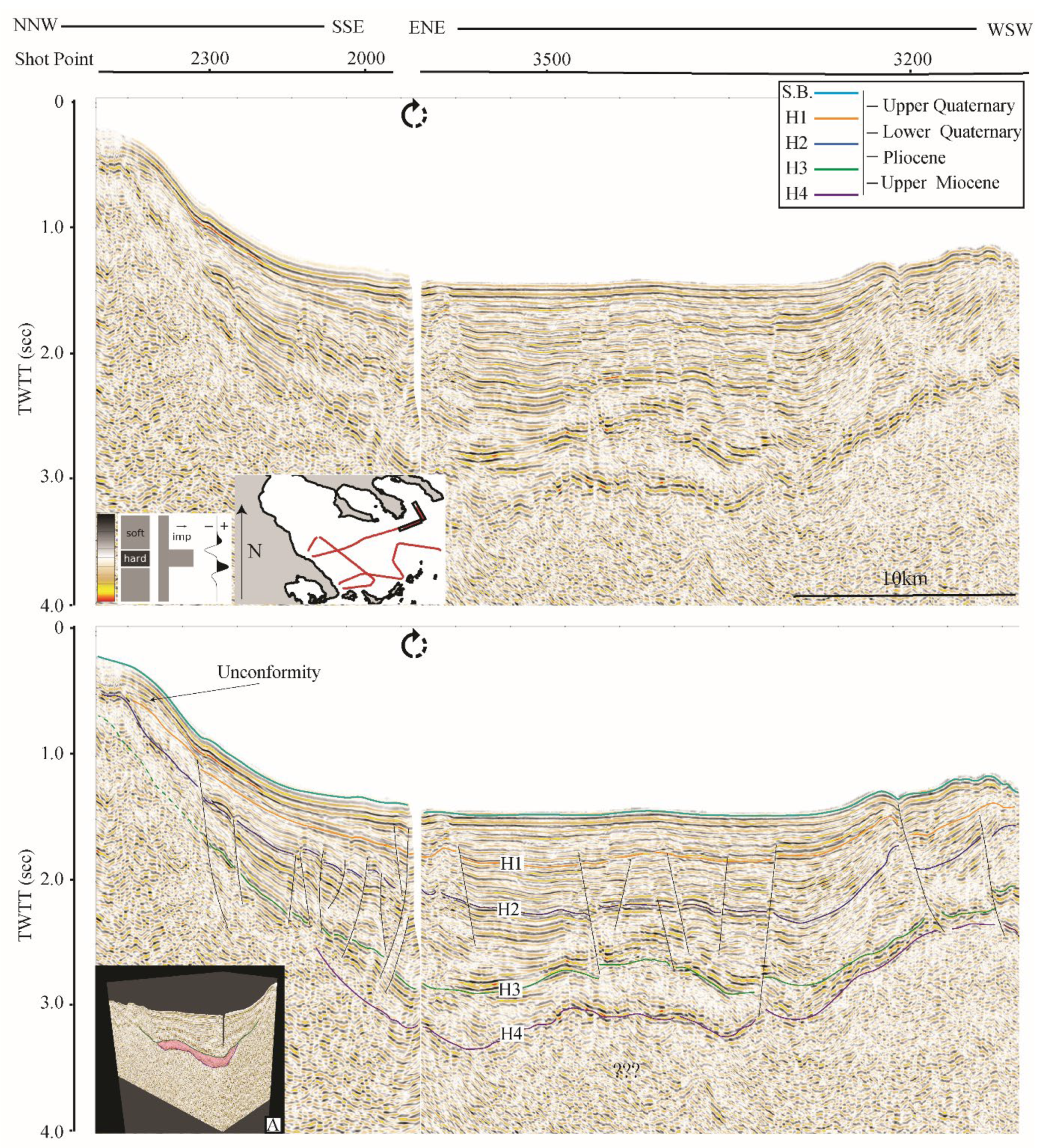
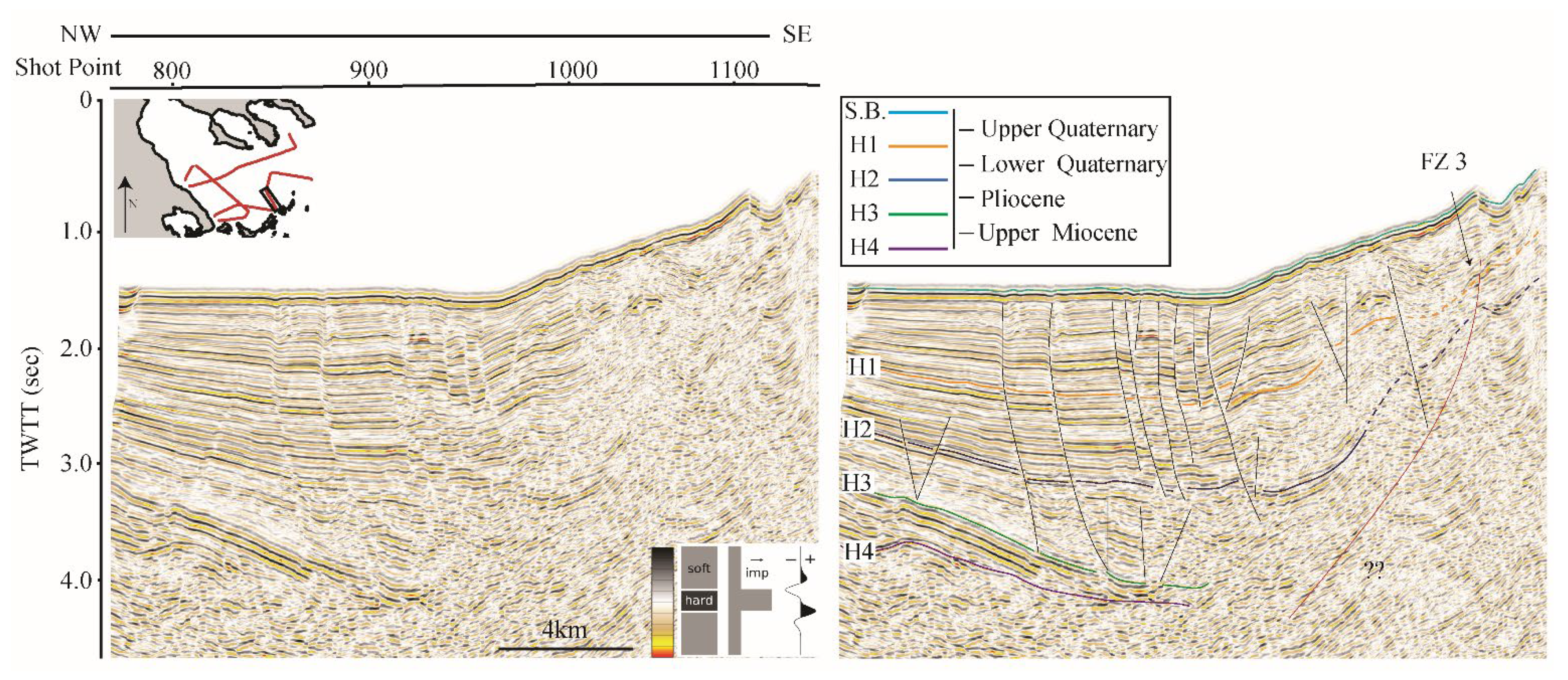
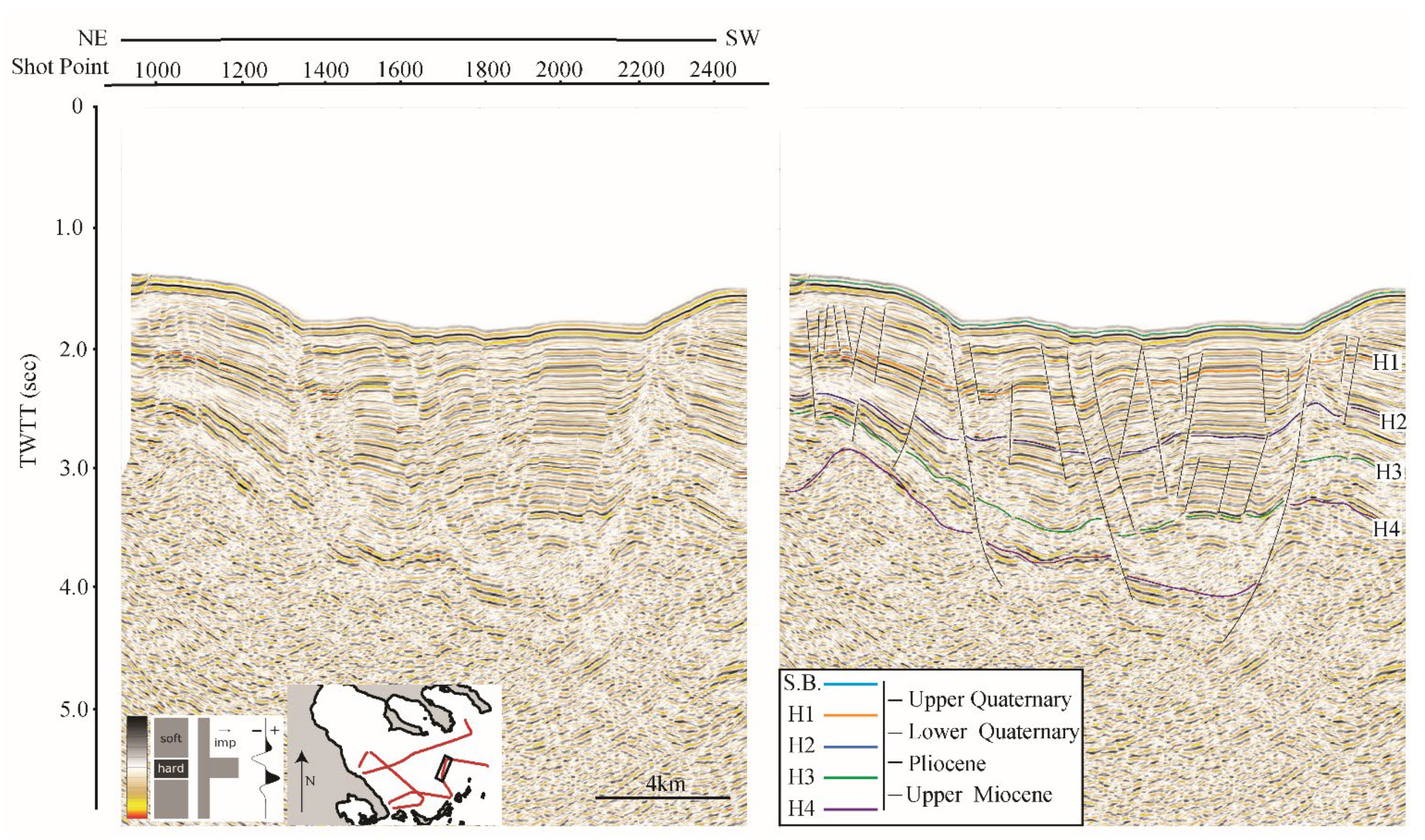
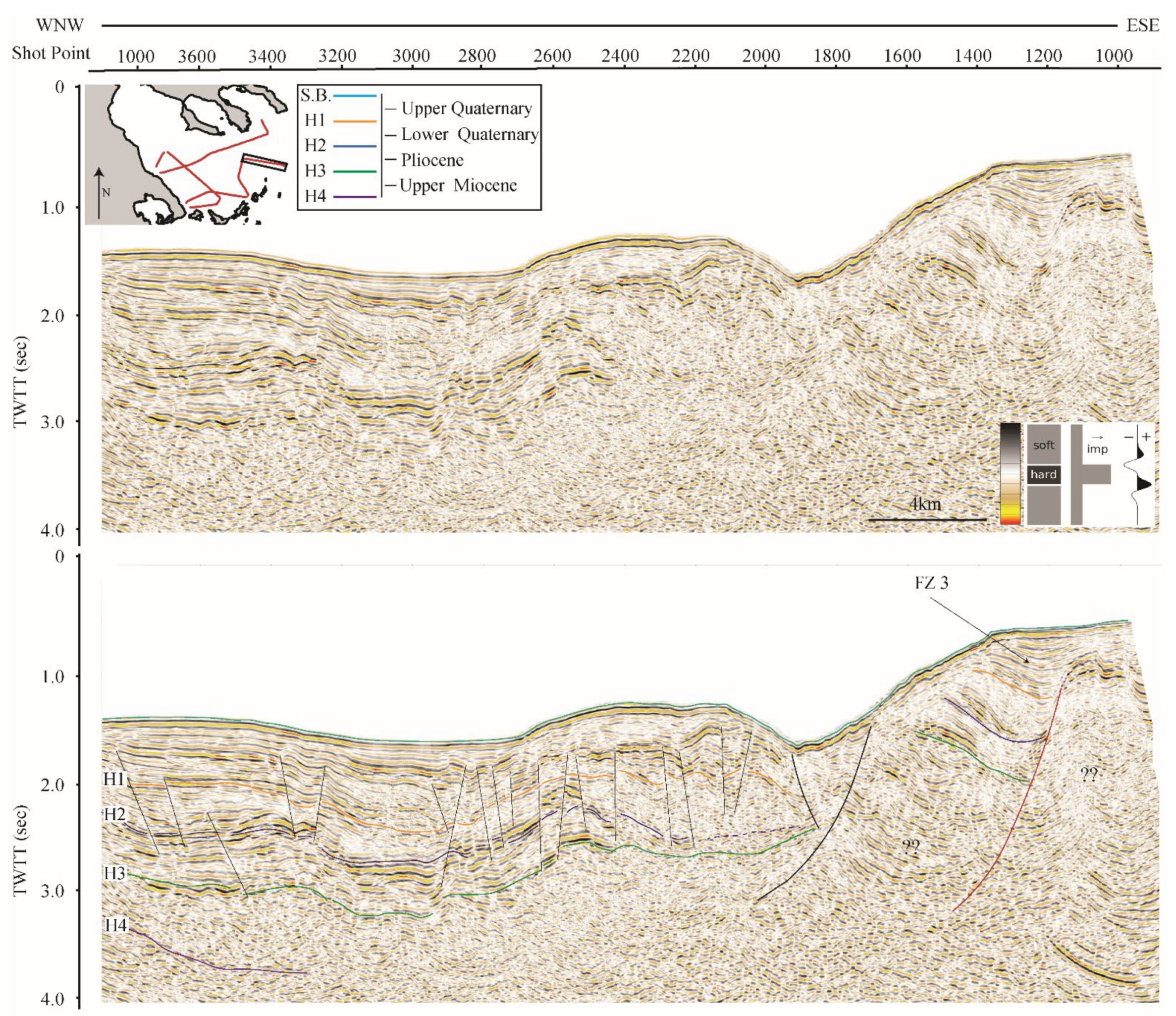

| Seismic Facies | Acoustic Signature | Internal Configuration | Lateral Continuity | Reflection Characteristics | Geometry |
|---|---|---|---|---|---|
| Si |  | Parallel Well Stratified | High | Moderate to High Amplitude High Frequency | Sheet-Shaped Basinwards Wedge-Shaped Landwards |
| Sii |  | Subparallel to Parallel Stratified with Internal Unconformities | Medium to High | Low to Moderate Amplitude High Frequency | Sheet-Shaped Basinwards Wedge-Shaped Landwards |
| Siii |  | Subparallel to Wavy | Medium | Moderate to High Amplitude Low Frequency | Sheet to Wedge |
| W |  | Wavy to Hummocky | Poor | Low to Moderate Amplitude Low Frequency | Complex-Irregular |
| M |  | Transparent to Hummocky | Discontinuous | High Amplitude Top and Bottom Reflectors and Low Internal Low Frequency | Lens Updoming Features |
| Ch |  | Chaotic to Non-Internal Configuration | Discontinuous | Low Amplitude | No Coherent Geometry |
Publisher’s Note: MDPI stays neutral with regard to jurisdictional claims in published maps and institutional affiliations. |
© 2021 by the authors. Licensee MDPI, Basel, Switzerland. This article is an open access article distributed under the terms and conditions of the Creative Commons Attribution (CC BY) license (https://creativecommons.org/licenses/by/4.0/).
Share and Cite
Varesis, A.; Anastasakis, G. Cenozoic Marine Basin Evolution in the Western North Aegean trough Margin: Seismic Stratigraphic Evidence. Water 2021, 13, 2267. https://doi.org/10.3390/w13162267
Varesis A, Anastasakis G. Cenozoic Marine Basin Evolution in the Western North Aegean trough Margin: Seismic Stratigraphic Evidence. Water. 2021; 13(16):2267. https://doi.org/10.3390/w13162267
Chicago/Turabian StyleVaresis, Alexandros, and George Anastasakis. 2021. "Cenozoic Marine Basin Evolution in the Western North Aegean trough Margin: Seismic Stratigraphic Evidence" Water 13, no. 16: 2267. https://doi.org/10.3390/w13162267
APA StyleVaresis, A., & Anastasakis, G. (2021). Cenozoic Marine Basin Evolution in the Western North Aegean trough Margin: Seismic Stratigraphic Evidence. Water, 13(16), 2267. https://doi.org/10.3390/w13162267





